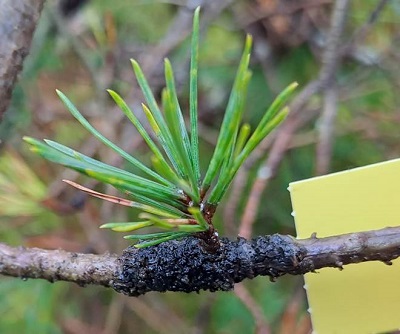The Iconic Caledonian Scots Pine: A New Health Threat and its Implications for Management
Caledonian pine is the name given to endemic Scots pine (Pinus sylvestris) which colonised Britain following the last ice age. These populations are found in the Scottish Highlands and despite their fragmented nature have huge ecological, conservation and cultural value due to the host of native flora and fauna which they support. For this reason, Scots pine is regarded as Scotland’s most iconic tree species. Recently however, attention has been drawn to a new health threat to Caledonian pine which is manifesting itself in the form of unusually abundant blackened cankers and dieback of shoots and branches, particularly in the lower crown.
In a project funded by the Scottish Plant Health Centre, Sarah Green (Forest Research), Jo Taylor (RBGE) and colleagues investigated the geographical distribution of symptoms on native and non-native Scots pine, identified and described the causal agents, and used historical, ecological and genetic information to shed light on this new health threat.
Typical symptoms of multiple black cankers and lower crown dieback were found on Scots pine across most regions of Scotland with an additional report from Devon, England. Trees were affected in native Caledonian pine forests, new native woodland plantings, commercial plantations as well as amenity and shelterbelt plantings. One of the primary causal agents was found to be the very distinctive yet previously rare fungus, Curreya pithyophila. This fungus forms a black stroma which encircles shoots, branches and sometimes the main stems of Scots pine, typically at branch junctions. The fungus itself remains superficial, but encased beneath the black fungal stroma are thriving nymph colonies of the native Scots pine woolly adelgid, Pineus pini, an aphid-like insect which feeds on the tree, initiating wounds. These wounds are then invaded by a longstanding wound pathogen of pine, Crumenulopsis sororia, a fungus which causes the blackened, perennating cankers that expand, killing branches.

Using information gained from past literature, and morphological and genetic analyses of fungal isolates collected from Scotland and Devon, the authors surmise that the current population of C. pithyophila in the UK comprises two distinct but co-occurring species. Historical reports suggest that previous C. pithyophila outbreaks occurred on plantation Scots pine in Perthshire in the 1900s and in north-east Scotland during the 1960s, with sporadic findings on individual trees from the 1970s onwards. The relatedness of current specimens of C. pithyophila to the fungal specimens which caused the previous outbreaks is unknown. Further investigations are required to understand the drivers behind this new, widespread outbreak of C. pithyophila on Scots pine in Scotland. These investigations will focus on determining whether one or both forms of C. pithyophila in Scotland represent new introductions into the UK or whether climatic factors have triggered the outbreak.
Since our research into this disease is still at an early stage it is hard to give an informed prognosis for the future health of Scots pine in Scotland. However, given that the presence of the adelgid is required for colonisation by C. pithyophila, that weak or stressed trees appear most susceptible, and infestations typically start on the lower branches, the authors offer the following interim recommendations for the management of Scots pine.
Scots pine management recommendations
- Plant only healthy stock which is visibly free of adelgids or fungal infection
- Source stock that has been propagated and grown in the UK by a reputable nursery, preferably one that is Plant Healthy certified Welcome to Plant Healthy - Plant Healthy
- Only plant Scots pine on sites that are deemed suitable for this species. The Ecological Site Classification (ESC) tool can be used to assess site suitability Ecological Site Classification (ESC) - Forest Research
- Match Scots pine provenance to site to ensure maximum vigour
- Early brashing to remove susceptible lower branches may help prevent the disease establishing
